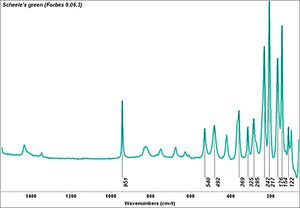Difference between revisions of "Scheele's green"
Jump to navigation
Jump to search
| Line 9: | Line 9: | ||
[[[SliderGallery rightalign|Scheele's green (Forbes 9.06.3) resize.jpg~Raman (MFA)]]] | [[[SliderGallery rightalign|Scheele's green (Forbes 9.06.3) resize.jpg~Raman (MFA)]]] | ||
| − | == | + | == Risks == |
| − | + | * Extremely toxic by ingestion, inhalation and skin absorption. | |
| + | * Human carcinogen. | ||
| + | * May produce toxic arsenic fumes when decomposed by fungi. | ||
| + | * NIH: [https://pubchem.ncbi.nlm.nih.gov/compound/Cupric-arsenite Info and SDS] | ||
| − | Decomposes in alkalis. Darkens in the presence of sulfur or lead compounds. | + | == Physical and Chemical Properties == |
| + | |||
| + | * Soluble in mineral acids. Insoluble in water. | ||
| + | * Decomposes in alkalis. | ||
| + | * Darkens in the presence of sulfur or lead compounds. | ||
{| class="wikitable" | {| class="wikitable" | ||
| Line 24: | Line 31: | ||
|} | |} | ||
| − | == | + | ==Resources and Citations== |
| − | |||
| − | |||
| − | |||
| − | |||
| − | |||
| − | |||
| − | |||
| − | |||
| − | |||
| − | |||
| − | + | * I.Fiedler, M Bayard, "Emerald Green and Scheele's Green", ''Artists Pigments'', Volume 3, E. West FitzHugh (ed.), Oxford University Press: Oxford, 1997. | |
* R. J. Gettens, G.L. Stout, ''Painting Materials, A Short Encyclopaedia'', Dover Publications, New York, 1966 | * R. J. Gettens, G.L. Stout, ''Painting Materials, A Short Encyclopaedia'', Dover Publications, New York, 1966 | ||
| Line 44: | Line 41: | ||
* R.D. Harley, ''Artists' Pigments c. 1600-1835'', Butterworth Scientific, London, 1982 | * R.D. Harley, ''Artists' Pigments c. 1600-1835'', Butterworth Scientific, London, 1982 | ||
| − | * Art and Architecture Thesaurus Online, | + | * Art and Architecture Thesaurus Online, https://www.getty.edu/research/tools/vocabulary/aat/, J. Paul Getty Trust, Los Angeles, 2000 |
* R. Newman, E. Farrell, 'House Paint Pigments', ''Paint in America '', R. Moss ed., Preservation Press, New York City, 1994 | * R. Newman, E. Farrell, 'House Paint Pigments', ''Paint in America '', R. Moss ed., Preservation Press, New York City, 1994 | ||
Revision as of 15:07, 15 June 2022
Description
A highly poisonous green pigment composed of Copper arsenite. Scheele's green was discovered in Sweden in 1775 by Carl W. Scheele, a German chemist, but he did not publish the recipe until 1778. It is a bright, warm yellowish-green with good opacity. Scheele's green was never widely used as a paint pigment because it was toxic and discolored in the presence of acid or sulfur fumes. Currently, copper arsenite is used as a rodenticide, Insecticide, fungicide, and wood preservative.
Synonyms and Related Terms
copper arsenite; cupric arsenite; Pigment Green 22; CI 77412; mineral green; ash green; vert de Scheele (Fr.); Scheelesgrün (Deut.); verde di Scheele (It.)
Risks
- Extremely toxic by ingestion, inhalation and skin absorption.
- Human carcinogen.
- May produce toxic arsenic fumes when decomposed by fungi.
- NIH: Info and SDS
Physical and Chemical Properties
- Soluble in mineral acids. Insoluble in water.
- Decomposes in alkalis.
- Darkens in the presence of sulfur or lead compounds.
| Composition | Cu(AsO2)2 |
|---|---|
| Refractive Index | 1.55 - 1.75 |
Resources and Citations
- I.Fiedler, M Bayard, "Emerald Green and Scheele's Green", Artists Pigments, Volume 3, E. West FitzHugh (ed.), Oxford University Press: Oxford, 1997.
- R. J. Gettens, G.L. Stout, Painting Materials, A Short Encyclopaedia, Dover Publications, New York, 1966
- Ralph Mayer, A Dictionary of Art Terms and Techniques, Harper and Row Publishers, New York, 1969 (also 1945 printing)
- R.D. Harley, Artists' Pigments c. 1600-1835, Butterworth Scientific, London, 1982
- Art and Architecture Thesaurus Online, https://www.getty.edu/research/tools/vocabulary/aat/, J. Paul Getty Trust, Los Angeles, 2000
- R. Newman, E. Farrell, 'House Paint Pigments', Paint in America , R. Moss ed., Preservation Press, New York City, 1994
- The Dictionary of Art, Grove's Dictionaries Inc., New York, 1996 Comment: 'Pigments'
- G.S.Brady, Materials Handbook, McGraw-Hill Book Co., New York, 1971 Comment: p. 610
- Michael McCann, Artist Beware, Watson-Guptill Publications, New York City, 1979
- Thomas B. Brill, Light Its Interaction with Art and Antiquities, Plenum Press, New York City, 1980
- Book and Paper Group, Paper Conservation Catalog, AIC, 1984, 1989
